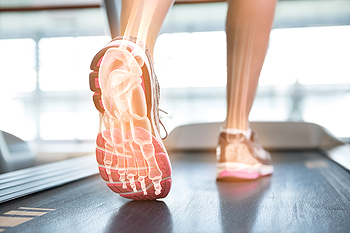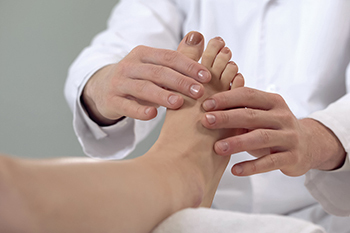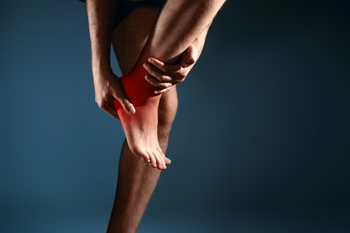Items filtered by date: September 2022
Foot Biomechanics 101

The study of how the foot moves through the gait cycle is called foot biomechanics. This is important in making sure your feet do not overpronate or over-supinate so the feet absorb shock when they hit the ground and propel forward movement properly. If the foot overpronates, it causes the foot to flatten too much and the ankle and knee to roll inward. This can increase the risk of injury and cause lower leg, hip, and back injuries. If the foot does over-supinate, it fails to roll in or flatten sufficiently and will not be able to absorb shock. Those who over supinate have high arches and less flexible feet. To prevent injuries from occurring from improper pronation, visit a podiatrist who can access your gait and analyze how your foot works. If something is wrong, a podiatrist can provide the proper treatment.
If you have any concerns about your feet, contact Charles Perry, DPM from Ohio. Our doctor can provide the care you need to keep you pain-free and on your feet.
Biomechanics in Podiatry
Podiatric biomechanics is a particular sector of specialty podiatry with licensed practitioners who are trained to diagnose and treat conditions affecting the foot, ankle and lower leg. Biomechanics deals with the forces that act against the body, causing an interference with the biological structures. It focuses on the movement of the ankle, the foot and the forces that interact with them.
A History of Biomechanics
- Biomechanics dates back to the BC era in Egypt where evidence of professional foot care has been recorded.
- In 1974, biomechanics gained a higher profile from the studies of Merton Root, who claimed that by changing or controlling the forces between the ankle and the foot, corrections or conditions could be implemented to gain strength and coordination in the area.
Modern technological improvements are based on past theories and therapeutic processes that provide a better understanding of podiatric concepts for biomechanics. Computers can provide accurate information about the forces and patterns of the feet and lower legs.
Understanding biomechanics of the feet can help improve and eliminate pain, stopping further stress to the foot.
If you have any questions please feel free to contact our offices located in Cambridge and Zanesville, OH . We offer the newest diagnostic and treatment technologies for all your foot and ankle needs.
Places to Wear Flip Flops

Flip-flops are a popular type of shoes that are worn during the summer months. They can be purchased in a variety of colors and styles, and are easy to wear. They are generally inexpensive to buy and can be fun to wear. Despite the appeal, these types of shoes may not be beneficial for the health of the feet. Flip-flops often have little or no arch support and the entire foot can be negatively affected. The toes often grip harder than they should to keep the shoes on the feet. They are appropriate to wear for short periods such as in public showers or locker rooms, and to the beach. When other activities are performed, it is suggested that sturdier shoes are worn that can better protect the feet. For more information about how the feet can be affected by wearing flip-flops, please consult with a podiatrist.
Flip-flops are not always the best choice of footwear. If you have any concerns about your feet or ankles, contact Charles Perry, DPM from Ohio. Our doctor will assist you with all of your foot and ankle needs.
Flip-Flops and Feet
When the weather starts warming up, people enjoy wearing flip-flops. Flip-flops are comfortable, stylish, and easy to slip on and off; they're perfect for any summer beach goer. However, these shoes can cause harm to the feet.
How Can Flip-Flops Affect Me Long-Term?
- Ankle problems
- Hip problems
- Lower back problems
- Pain in the balls of the feet
- Problems with foot arches
- Changes in the way you walk
Are There Injuries Associated with Flip-Flops?
Yes. Since flip-flops are relatively weak and do not provide the same amount of support as sneakers, people who wear flip-flops regularly are more susceptible to injuries. On top of that, the open nature of the shoe makes your feet more prone to other problems, such as cuts and even infections. Common injuries and ailments include:
- Sprained ankles
- Blisters
- Infections
- Cuts and Scrapes
I like Wearing Flip-Flops. Are There Safe Alternatives?
When buying flip-flops, try to find ones that have sturdy soles and that are made of high-quality materials that will support for your feet. These flip-flops will cost more but will also last longer as a result.
If you have any questions please feel free to contact our offices located in Cambridge and Zanesville, OH . We offer the newest diagnostic and treatment technologies for all your foot and ankle needs.
Symptoms of Tarsal Tunnel Syndrome

When the tibial nerve becomes compressed on the inside of the ankle, an individual can experience a condition known as tarsal tunnel syndrome (TTS). This affliction has a wide variety of causes. Suffering an ankle injury that causes inflammation can eventually pinch the tibial nerve and cause TTS. Also, individuals living with diabetes or arthritis can exhibit the swelling that eventually causes TTS. A person who has developed TTS could experience any number of different symptoms. First, the most common symptom of TTS is sharp pain along the tibial nerve. Interestingly, the pain can sometimes feel as if it is emanating from several different places, which is why TTS is sometimes confused with other conditions. Besides sharp, shooting pain, an individual might also experience a “pins and needles” sensation where the affected foot feels numb and almost tingly. It is important to note that these symptoms can sometimes worsen with increased physical activity. However, some individuals with TTS do experience pain and other symptoms while at rest or during the nighttime. If you have noticed any of these symptoms, schedule an appointment with a podiatrist today. This foot specialist can diagnose any foot condition you may have and help you treat the problem.
Tarsal tunnel syndrome can be very uncomfortable to live with. If you are experiencing tarsal tunnel syndrome, contact Charles Perry, DPM of Ohio. Our doctor can provide the care you need to keep you pain-free and on your feet.
Tarsal Tunnel Syndrome
Tarsal tunnel syndrome, which can also be called tibial nerve dysfunction, is an uncommon condition of misfiring peripheral nerves in the foot. The tibial nerve is the peripheral nerve in the leg responsible for sensation and movement of the foot and calf muscles. In tarsal tunnel syndrome, the tibial nerve is damaged, causing problems with movement and feeling in the foot of the affected leg.
Common Cause of Tarsal Tunnel Syndrome
- Involves pressure or an injury, direct pressure on the tibial nerve for an extended period of time, sometimes caused by other body structures close by or near the knee.
- Diseases that damage nerves, including diabetes, may cause tarsal tunnel syndrome.
- At times, tarsal tunnel syndrome can appear without an obvious cause in some cases.
The Effects of Tarsal Tunnel Syndrome
- Different sensations, an afflicted person may experience pain, tingling, burning or other unusual sensations in the foot of the affected leg.
- The foot muscles, toes and ankle become weaker, and curling your toes or flexing your foot can become difficult.
- If condition worsens, infections and ulcers may develop on the foot that is experiencing the syndrome.
A physical exam of the leg can help identify the presence of tarsal tunnel syndrome. Medical tests, such as a nerve biopsy, are also used to diagnose the condition. Patients may receive physical therapy and prescriptive medication. In extreme cases, some may require surgery.
If you have any questions please feel free to contact our offices located in Cambridge and Zanesville, OH . We offer the newest diagnostic and treatment technologies for all your foot and ankle needs.
What to Do About Blood Blisters

Blisters on the feet are the result of repeated friction between the skin and a harder surface, usually the inside of a shoe. When friction continues, the body goes into action to protect itself by forming a fluid-filled blister. If the action that caused the blister continues, however, blood vessels may be ruptured resulting in a blood blister. Causes of blood blisters include demanding activities like dancing, hiking, and running. One way to avoid the formation of blood blisters is to wear shoes that fit properly and provide adequate cushioning. It also may help to wear moisture-wicking socks to minimize friction. Placing an ice pack on the affected area can help to ease the pain and any swelling or inflammation. Soaking the injured area in Epsom salt, which contains magnesium sulfate, is also beneficial and can further promote healing. However, if the blood blister is too painful or becomes infected, it may be time to visit a podiatrist for further treatment solutions.
Blisters are prone to making everyday activities extremely uncomfortable. If your feet are hurting, contact Charles Perry, DPM of Ohio. Our doctor can provide the care you need to keep you pain-free and on your feet.
Foot Blisters
Foot blisters develop as a result of constantly wearing tight or ill-fitting footwear. This happens due to the constant rubbing from the shoe, which can often lead to pain.
What Are Foot Blisters?
A foot blister is a small fluid-filled pocket that forms on the upper-most layer of the skin. Blisters are filled with clear fluid and can lead to blood drainage or pus if the area becomes infected.
How Do Blisters Form?
Blisters on the feet are often the result of constant friction of skin and material, usually by shoe rubbing. Walking in sandals, boots, or shoes that don’t fit properly for long periods of time can result in a blister. Having consistent foot moisture and humidity can easily lead to blister formation.
Prevention & Treatment
It is important to properly care for the affected area in order to prevent infection and ease the pain. Do not lance the blister and use a Band-Aid to provide pain relief. Also, be sure to keep your feet dry and wear proper fitting shoes. If you see blood or pus in a blister, seek assistance from a podiatrist.
If you have any questions, please feel free to contact our offices located in Cambridge and Zanesville, OH . We offer the newest diagnostic and treatment technologies for all your foot care needs.

